November 30, 2021
Inflation is rising, stocks are falling and more and more figures in economics are suggesting a correction or financial crash is in the mail.
In The Young Hustler, I suggest there are some parallels to be drawn when it comes to current uncertainty and the financial crash of 1929 that led to the Great Depression. It was in these years of the early 1930s when men lined up outside distribution centres with gunny sacks to get enough food for their families to last the week, when my grandfather began working on the Young Hustler on the North Arm of the Fraser. After a shakedown period, in 1932 he began operating the small, capable tugboat, for a small stipend. It was not much money to live on, but it was the work that he loved to do.
For many years, as a boy, Jack Hughes would run to a nearby sawmill, where the tug operators and crews would congregate, and listen to them as they told their stories. Once he became a tug operator himself, Jack wasn’t in it for the money. He loved the work itself: navigating the open water, the smell off the low-lying fields and marshes, the camaraderie he found with the various tugs and crews. He was doing the work he had dreamed of doing while a boy, and as a young man, he felt satisfied, despite a day off being rare.
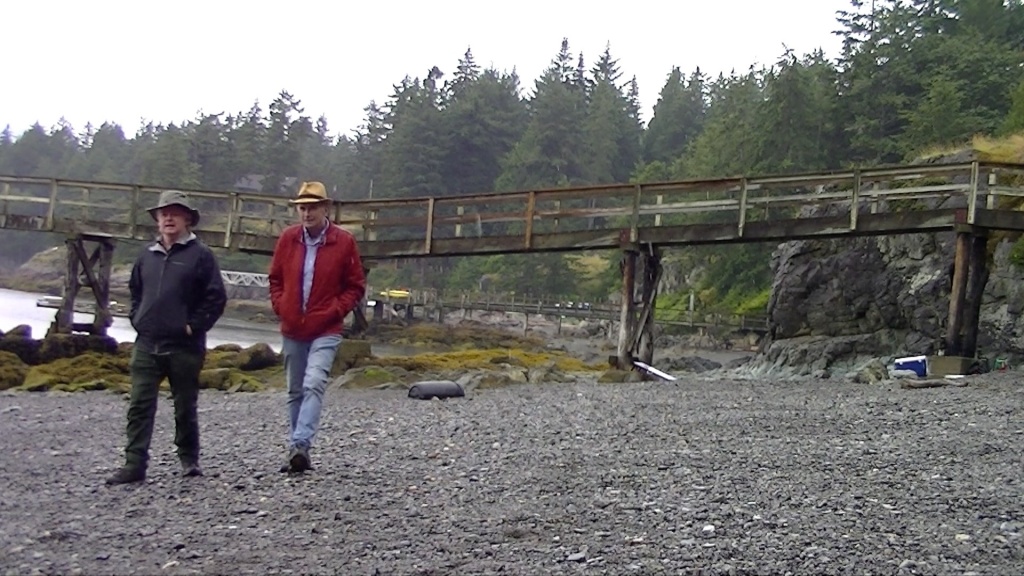
October 22, 2021
I’ve taken many walks along the North Arm Jetty and Fraser River Park over the last year-and-a-half. During walks early in the pandemic, in the spring and summer of 2020, I remembered that my grandfather had a history along this river. I visited my uncle, Paul Hughes, Jack’s youngest son, on Bowen Island. Paul kept a box of photographs and handwritten notes belonging to Jack. Over the course of a rainy day we’d pore over old black and white pictures and notes written when Paul’s father was young and alive.
Jack Hughes died in 1997. In my childhood visits to his, and my grandmother Ethel’s, home in Crofton on Vancouver Island, I’d know the old man he had become, weathered and made weary through life’s disappointments and a heart that was giving out on him. That day on Bowen Island I saw him as a young man, full of vigour, smiling and barefoot by the side of a river where he lived, an ebullient and ambitious young man in the 1930s.
Without really knowing what I was doing, I brought an HD video camera and a small tripod down to the river, having walked along the Arbutus Greenway in Kerrisdale until I got to Marpole, eager to capture the summer atmosphere at Fraser River Park, see the river at Jack’s favourite bit of the river at Marpole, where he would have brought the Young Hustler up, smelling the low lying marshes and farmer’s fields. He wrote it was something to remember. His days operating the Young Hustler as a young man were some of the happiest days of his life.
Much of his work was assisting larger tugs their lengthy tows of log booms through the Marpole bridge, or sometimes helping large tug and snagboat sternwheelers with their dredging, sometimes yarding up logs, wherever their was work.
For the last year I’ve been revisiting the places he walked, lived and rested, specifically the North Arm Jetty, where, long before there was a regional park, Iona Island’s jetty was an ideal place for a young man, with rare time off, to rest under the stars, campfire blazing, while looking out to the strait to watch the Canadian Pacific steamships cruise along to and from Vancouver harbour.
Without the pandemic to slow things down, I don’t know if I’d have taken the time to reflect in such a way, and take on a creative project that told Jack Hughes’ story. One thing is for certain: there is something to appreciate in seeing my grandfather in his days of glory on the Fraser River.
September 30, 2021
My grandfather, Jack Hughes, had an ability to observe and note, as objectively as he could, the people who lived along the North Arm of the Fraser, and that tendency continued with the Musqueam. He observed how they were steadfast beachcombers, and logs that broke away from booms and found their ways into the numerous channels on Musqueam reserve were quickly taken on, and taken to a nearby sawmill. Jack observed and admired their traditional ways of life from the wheelhouse of the Young Hustler or from a rowboat. Jack would have been fishing from the river and bringing what catch he could manage back home to his shack on the river, along with whatever measly pickings he could scrounge from local farmers’ fields on the south side. It was the Great Depression after all, and self-sufficiency and the ability to find your own food from what the river provided, was an admirable skill. There is no doubt in my mind that Jack Hughes admired the Musqueam, and sought to learn as much as he could from that community along the North Arm.
September 4th, 2021
I was strolling in Fraser River Park, something I do fairly regularly in these strange times. But while I might have seemed preoccupied by the slowly flowing river and the booms and barges rimming its shores, an overwhelming number of visitors seemed preoccupied with their dogs. In fact, I was the only visitor without one.
It wasn’t dogs, but dolphins I came down there to see.
Just to the right of the beach was a collection of log booms, gently undulating in the wake of a passing tugboat, the movement hypnotic. The booms had been fastened to vertical groupings of three pilings, driven into the river bottom, which act as something for log booms to be attached to. Single logs that have been driven into the river shores are called pilings. But these clusters of three logs, or more common nowadays steel pipes, are known as dolphins. Dolphins used to be driven in close to shore but nowadays dolphins aren’t placed as close to shore so as to protect natural habitat.
It was hard to ignore how the North Arm had been transformed from natural feature to working river. Much of that change happened during my grandfather’s days on the Young Hustler in the 1930s and 1940s. Log storage grounds began rimming the river, from the North Arm Jetty near the area simply known as the Booming Grounds and eastwards upriver all the way up to New Westminster. Logging camps up the B.C. coast would assemble these single flat booms, or attach them into bundle booms that stretch for great distances, towed by a single large tug. That boat would bring them into the mouth of the North Arm where they were stored in booming grounds waiting for the right turn of the tide or the right time to be towed further upriver to sawmills by small capable tugs. Booms consisted of boomsticks and swifters and cables or chains kept them together. Many of the old rusting chains and cables I find on the long beach walk at the North Arm Jetty no doubt came from this process, one that began in Jack Hughes’ day, and continues today.
May 12th, 2021
It’s the many walks I had during the initial part of this pandemic, the reflection that came about because of those walks, that I have to thank for my continuing to investigate my grandfather’s days on the Fraser in the 1930s.
Where do I come from?
Who was my grandfather?
What did he do?
What do I remember of him?
What did he leave behind?
How did he live?
These questions came up on these walks, and as I delved into the green file folder that contained more images and artifacts from my grandfather’s days spent in the wheelhouse of several tugs, I found ways to answer some of them. There are tools of his in my toolbox. One is a massive, heavy British-built wrench. I’ve taken it out, felt its weight and wondered as to the variety of jobs it was used for when maintaining and fixing engines (which Grandad was known to do).
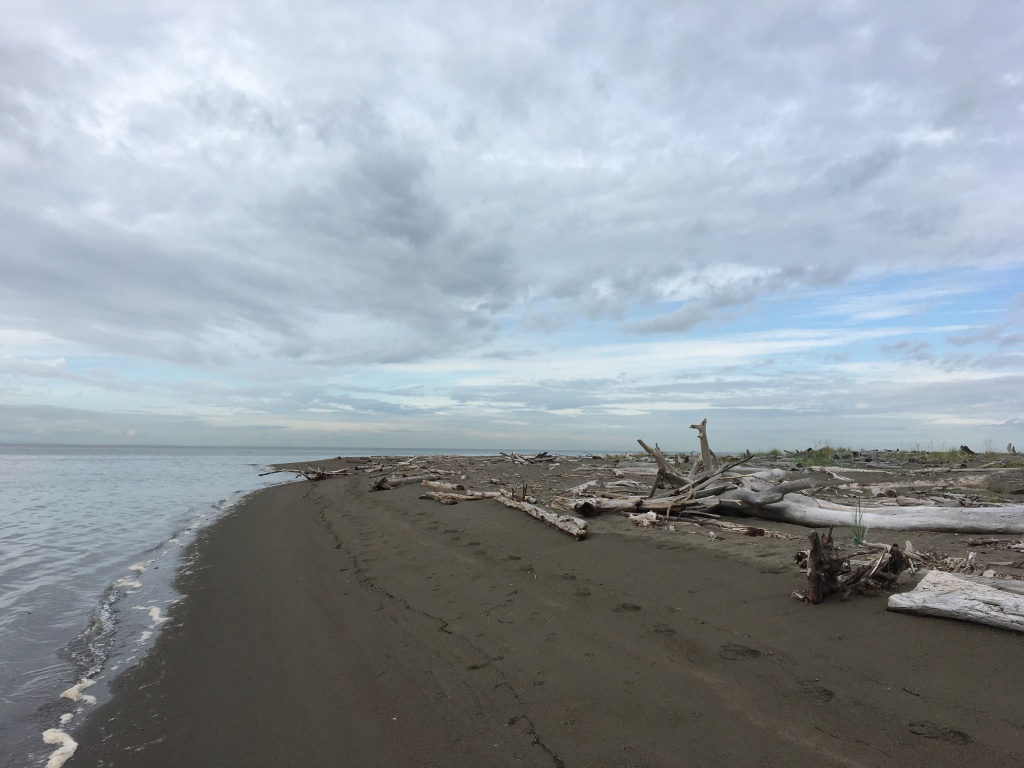
But those walks along the boardwalks of Fraser River Park and the sandbars of the North Arm Jetty were also improving my health. As I age, I’m becoming all too aware of my own lifespan, and how exercise will be very important should I wish my health, physical and mental, to be maintained. Walking along the jetty and realizing that Jack Hughes spent many happy occasions camping overnight on its sandbars (when it was possible to camp overnight there, before it became part of a regional park) has also brought me a kind of understanding of who he was and what interests I share with him. The North Arm Jetty is a beautiful spot, and although a long walk is necessary to truly feel its splendour, it’s a long walk that is well worth it.
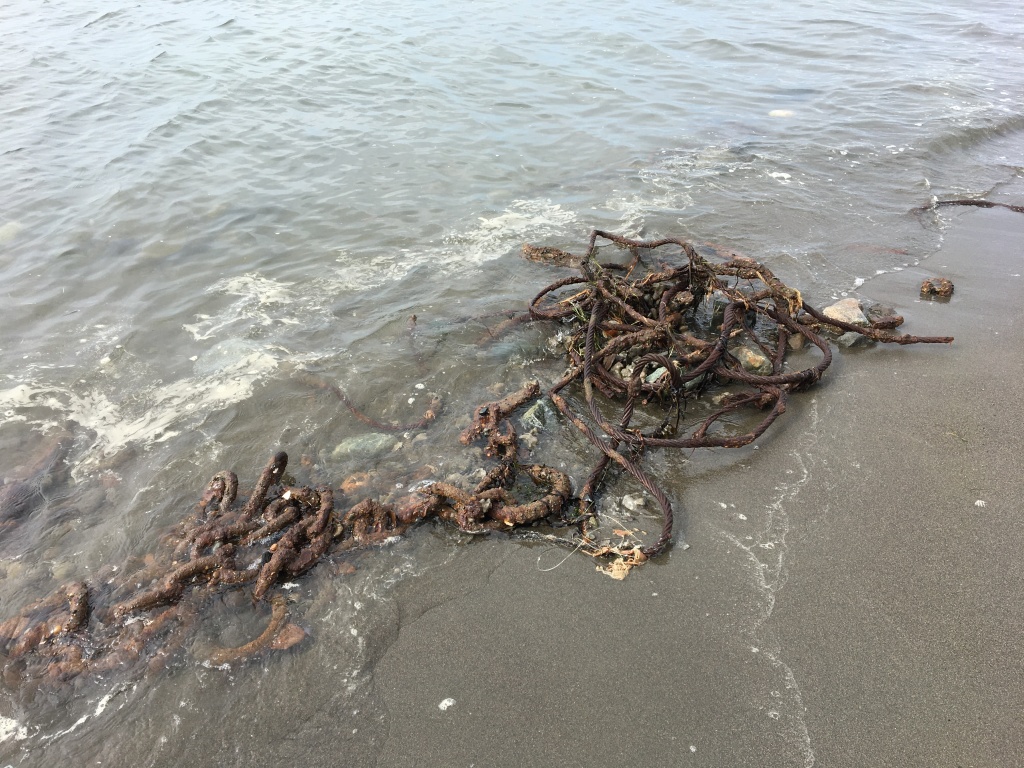
An interesting aspect of the walk out along this lengthy sliver of sand, is finding artifacts rusting away at low tide. The boomchains, cables, and once, even an orphaned log boom (that perhaps dislodged itself from a dolphin, or came loose off a tow) are testaments to British Columbia’s economic association with lumber over the last century or more. Even the length of the jetty itself was decided upon to protect the booming grounds of the Point Grey Flats from the westerly winds and to prevent log spoilage for the future lumber stored there.
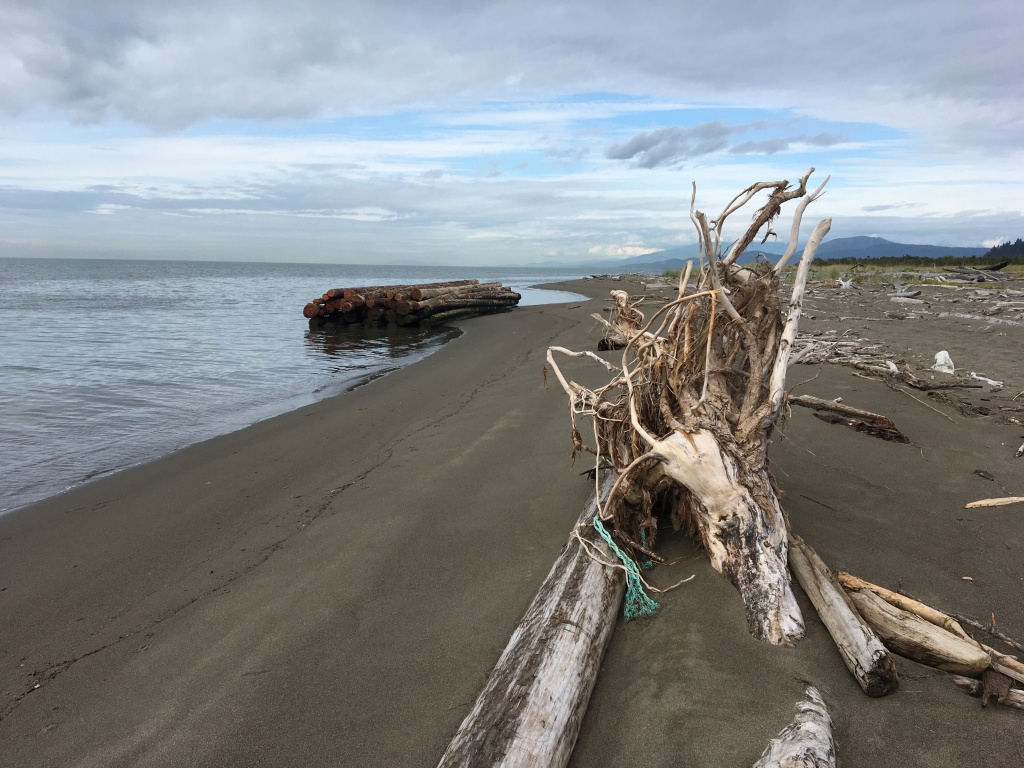
So I suppose I have the sawmills to thank for my long scenic walks out to the far end of the jetty, or at least as far as the tide will allow me. But it’s the knowledge that my grandfather camped out there that keeps me coming back, and I usually find a new artifact half-submerged in the sand or washed up on the beach that represents the time in which he lived.
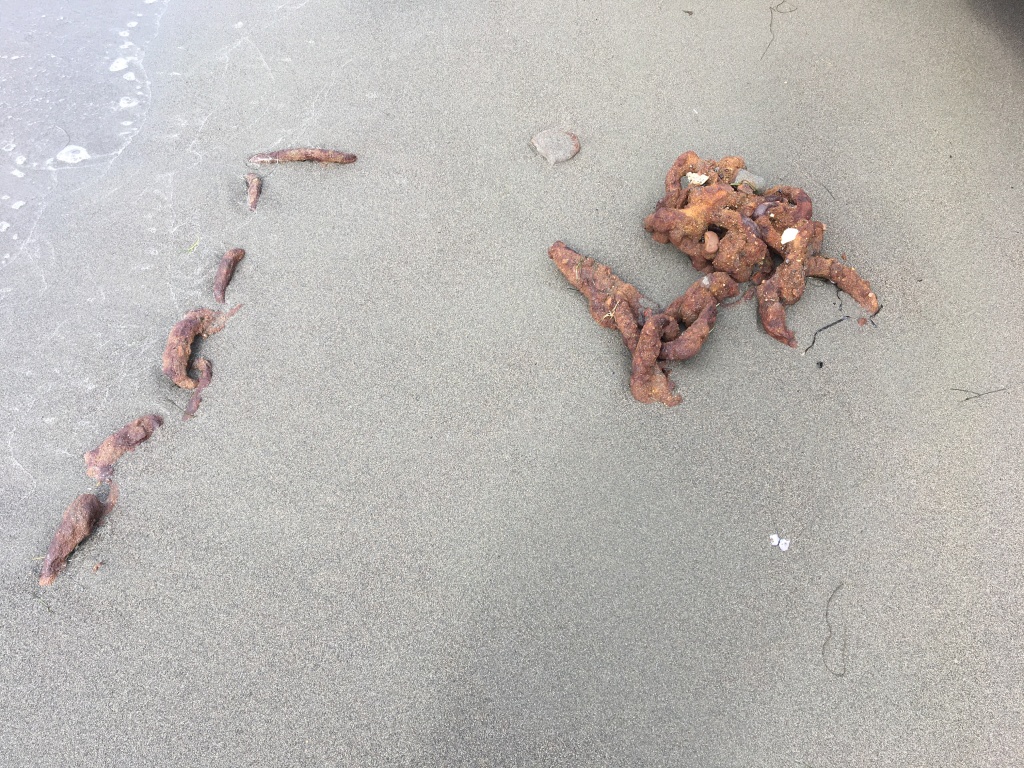
April 7th, 2021
I think the idea for the documentary began back in November 2019 as I started taking walks along the paths of Fraser River Park. I didn’t immediately begin consulting my grandfather’s memoirs upon walking along the river, but I started learning more about the river with every visit. Signage placed at different points along the park paths made reference to the past uses of the land, how the park came to be and to visible structures in the river.
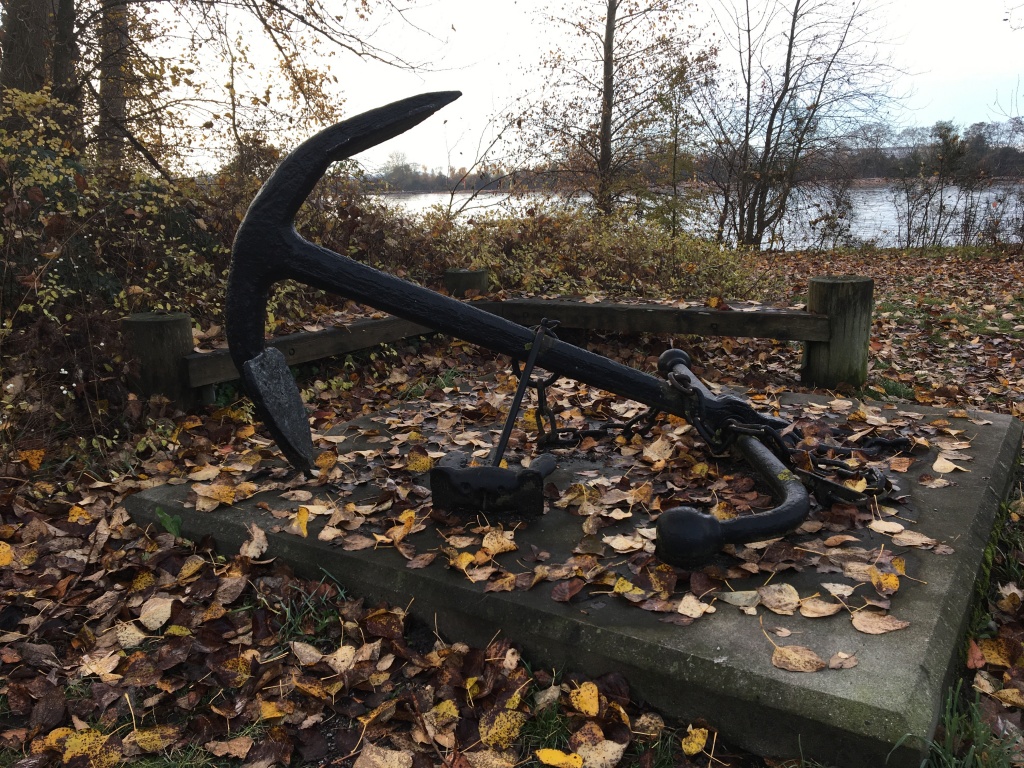
At the time, I was dealing with the death of a good friend, and also with anxiety and depression. The walks by the river calmed me and I really enjoyed the peace that they brought me. I began thinking about my grandfather, who I knew had had a working life on the Fraser, but knew few details. I had a photograph of the first tugboat my grandfather worked on in a green file folder in my filing cabinet, a folder I’d kept from when I was doing research into his life on tugboats for a CBC Radio documentary I made back in 1999. The photograph was taken in 1932, and it featured the Young Hustler moving east on the North Arm of the Fraser, at the section at Marpole…possibly very close to where I was taking my long walks along the paths of Fraser River Park.
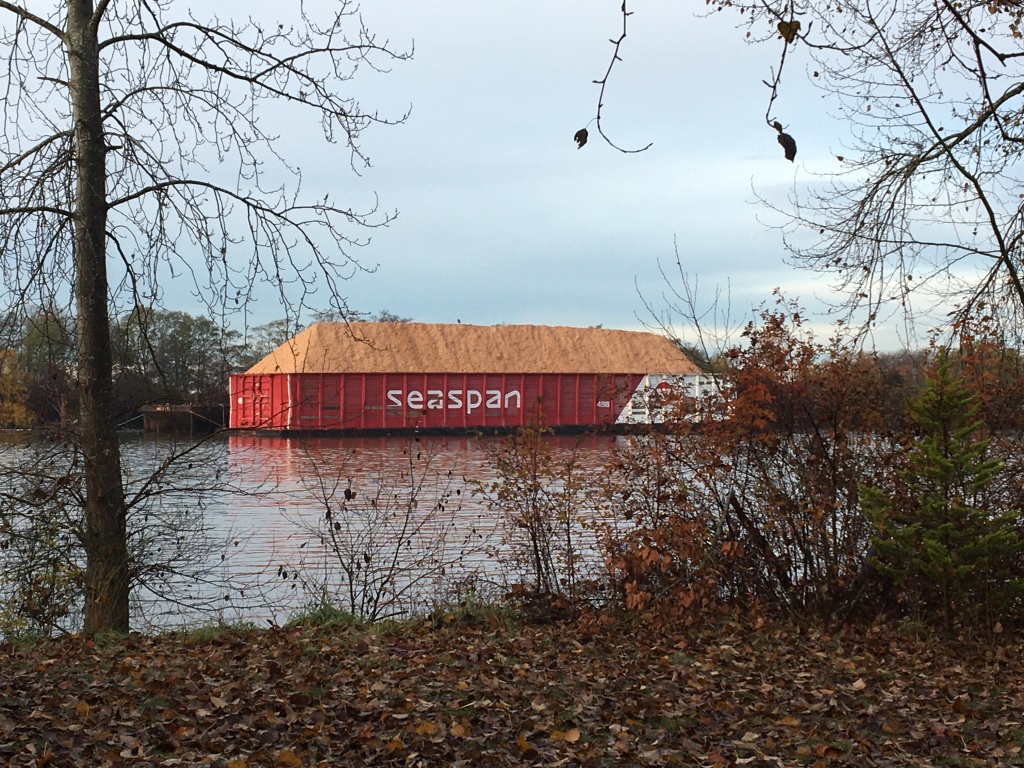
I read the signage throughout the park, learning more about this place. There was a lot of history here. I knew this was unceded Musqueam land, but one sign took me back to the state of it prior to the early 1980s. It was sad to read that the current-day grassy fields and treed expanses, the marshy nooks clearly habitat for local waterfowl, were nothing more than a dumping ground back then: a space that may be developed by some future entrepreneurial endeavour, or left in its industrial decay. But that thought was tempered by the fact that local residents had supported the rejuvenation of this place as a local park. Years later I appreciated their efforts to encourage the natural surroundings along, build boardwalks to leave little impact on a rejuvenated part of the Fraser River foreshore, and allow wildlife to return. Some visits had me feeling as something of a minority, as I had no dog with me. But I’d hoped that dog owners might be sensitive to the vision of those local residents who wanted to see this place returned to a degree of natural splendour.
About me on my walks were marshes, little backwaters where ducks and herons took shelter and looked for food, trees and shrubs that hosted a variety of songbirds. I would sit at a bench and gaze across the water to Sea Island, perhaps watch a plane taking off from Vancouver International Airport or a pleasure boat slowly motoring along. But eventually I started watching the tugboats.
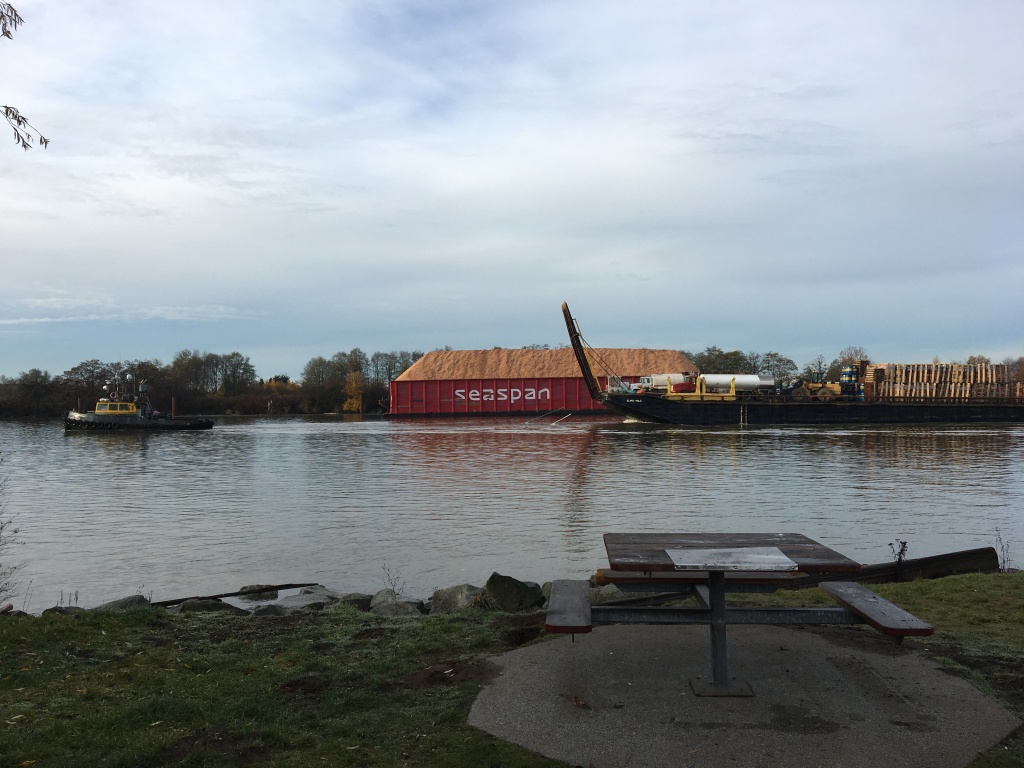
They were big and small, old and new, towing log booms, scows or large barges. The payloads would range from wood chips, perhaps destined for a pulp and paper mill, to construction equipment on its way to a building site on a gulf island. I remarked on how timeless these tugboats seemed…the working tugs, keeping our economy going, making their slow progress up the river or out to the open sea beyond the North Arm Jetty. It was in thinking more about what they did, had done, for British Columbia’s economy over the last century, with a slow, unnoticed power not unlike the current of the river itself, that I was brought to what my grandfather did, labouring for many years on board a wide variety of tugboats. But it was that first one, the Young Hustler, and this river, that I remember having heard at some point, had been a happy time, one where he had worked hard and had a pleasant youth living by the river. I decided to look more into the family records, but, for the moment, I’d savour the quiet at the river, and imagine what it must have been like in Jack Hughes’ prime. It would still take several more visits to Fraser River Park for the idea for the film to solidify…
March 17th, 2021
Happy Saint Patrick’s Day everyone!
My son Michael and I took a long walk recently, as we’ve been doing a lot lately and we strolled two hours from home down to the North Arm of the Fraser. As we ambled along the pathways of Fraser River Park, I looked out to the river and said to Michael: “I don’t think I’ll ever look the same way at that river again.”
Learning about what the North Arm of the Fraser meant to my grandfather, how many hours he worked on it on board the Young Hustler and how well he knew its moods and tides, I’ve developed a whole new way of seeing it. For many years it was just something to cross over on a bridge on the way to the airport or my son’s latest hockey practice. Now I see how an entire generation of people lived off of it, whether it was yarding up logs or fishing from it. I don’t see too many folks fishing on the river these days, but I still see tugboats doing what they’ve done for over a century: pulling a barge or a log boom, getting a valued commodity to its market. My grandfather lived by the tides, and worked all the time and much of who he was can be seen by looking at that river. I’ve gotten to know my grandfather in a whole new way over this past year, and pointing out to my son that there’s a great deal of family history on that river is something I’m glad to show him.
March 6th, 2021
One of the things that has fascinated me throughout making this film has been observing the river in its different moods, in different seasons. I’ve made a few short vignettes, to not only show the North Arm of the Fraser in these different circumstances, but also give a sense of its continuity. Back in my Grandad’s day, working on the Young Hustler in the 1930s, it actually got so cold that the river froze over solid. It didn’t get THAT cold when I brought the camera down to Fraser River Park this past winter, but there was some ice and always there seemed to be some resilient goose or mallard getting by.
Last summer I brought the camera down to the same section of the river, at Marpole, where Jack Hughes loved to navigate the river. At dusk I captured a Canada Goose family, with many goslings in tow, munching on the tall grass and having an outing on the river.
January 29th, 2021
The only elements needed for the first rough cut are some present day shots at McDonald Beach Park near Iona Beach, in Richmond. This is so I can contrast the archive photographs I have of the North Arm of the Fraser River from a hundred years ago with how it looks today from about the same place. I do hope that it’ll snow this winter, as I could use some footage of snow falling on the river, but I can do without it if it doesn’t happen. It’s exciting to make progress on a story that takes in the early life of my grandfather. But also it’s been interesting to develop the arc of the story that looks at how he survived the most difficult years of the Great Depression, while gathering the experience that would serve him his entire life.
October 24th, 2020
Much of the time, my Grandad Jack Hughes lived in the family’s cabin on the North Arm of the Fraser River, at the foot of Argyle Street near where the Knight Street Bridge is today. Then, during the Great Depression years, people lived in clumps of cabins along the river that resembled small villages. The Hughes family also had a house up on East 61st Avenue. But I think young Jack liked the action down by the river (where they had a few boats and a canoe), especially when he heard a whistle from the bridge of an approaching tugboat, the signal it was going to put in its log boom tow at the nearby Western Hemlock Mill. He would get to know the various tugboats and their skippers and crews, and would eventually find his way through those contacts to the bridge of the Young Hustler in 1932, a boat owned by Burt & Reid, putting in his own tows in the various sawmills that dotted the river’s edge. Jack was not yet out of his teen years. He loved being on the river and working on a tugboat. He loved slowly navigating past Marpole, perhaps on his way to New Westminster or beyond, smelling the farmers fields and the low-lying marshes.
As I research the mills of the time and find archived photographs, it is illustrating for me how much they kept the economy going during uncertain economic times. My grandfather had been part of that effort, even though his pay had been quite modest. I’m learning that he probably would have worked on the Young Hustler for free.
October 2, 2020
My grandfather’s name was Jack Hughes. He worked on tugboats during the Great Depression along the North Arm of the Fraser River in the Lower Mainland of British Columbia. He was born in 1913 just off the Fraser River, at the foot of Victoria Drive. The Fraser River would prove to be a big part of his life. As a boy he would run down from the family house on East 61st when he heard the whistle from the bridge of an approaching tugboat. This meant that a large tugboat was on its way with several other tugs helping it with its tow, a log boom destined to be put in at a nearby lumber mill. He met and talked with the crews of the boats, he’d ask questions and sometimes he’d go aboard. He loved it and he’d eventually work on the river himself. In the photographs I’ve seen of him in those days he always had a big smile on his face. His life, despite hard economic times, seems to have been fairly idyllic but was also full of hard work.
I’m making a documentary film about his early days on the North Arm of the Fraser, when, not yet twenty, he would get his first shot at being one of those guys who he met when he ran down to the river to meet the tugboat crews. Piloting the Young Hustler, he would make the most of these difficult times beginning a life on the sea. I hope to find out what wisdom he might have for his grandson as we head in to our own economic downturn and what made life on the North Arm of the Fraser so enticing for a young man with the spirit of adventure and a love of the water.
